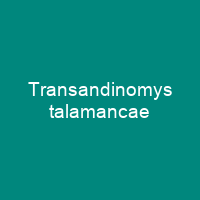Discovering the Enigmatic Transandinomys talamancae
Imagine a small, brightly colored rodent with reddish-brown fur and long vibrissae, navigating through the dense forests of Central and South America. This is Transandinomys talamancae, a fascinating species that has intrigued scientists for over a century. First described by Joel Asaph Allen in 1891, this medium-sized rice rat has undergone numerous taxonomic revisions, reflecting its complex evolutionary history.
A Taxonomic Journey
Allen initially placed Oryzomys talamancae within the genus Oryzomys. However, in 2006, Marcelo Weksler’s phylogenetic analysis revealed that this species deserved its own distinct genus, Transandinomys. This move was based on genetic differences and morphological characteristics that set T. talamancae apart from other rice rats.
Morphological Features
The physical attributes of Transandinomys talamancae are quite distinctive. With a head and body length ranging from 105 to 151 mm, a tail length between 105 and 152 mm, and hindfoot lengths of 26 to 32 mm, this species is medium-sized but not overly large. Its reddish-brown upperparts contrast with white or buff underparts, making it visually striking in its natural habitat.
The skull of T. talamancae exhibits a long rostrum and broad interorbital region, setting it apart from closely related species like Hylaeamys alfaroi. The zygomatic plate is also notable for its broadness with a developed notch at the front. These features contribute to the unique identity of this rodent.
Ecology and Behavior
Living on the ground, Transandinomys talamancae is an active nocturnal creature. It nests above ground level and occasionally uses burrows left by other animals. This species has a diverse diet that includes plant material, seeds, fruits, adult insects, and their larvae.
The reproductive habits of this rodent are also noteworthy. Females can produce up to six litters per year with an average of 3.92 young per litter. While the gestation period is about 28 days, there’s some variation in wild populations. This high reproductive rate contributes to its abundance and widespread distribution.
Conservation Status
Despite facing no immediate conservation concerns, Transandinomys talamancae is found in numerous protected areas across its range. Its ability to thrive in disturbed habitats further underscores the species’ adaptability and resilience.

Through its journey from Oryzomys to Transandinomys, T. talamancae has captivated the attention of taxonomists and ecologists alike. Its unique morphology, diverse habitat preferences, and reproductive strategies make it a fascinating subject for ongoing research.
In conclusion, Transandinomys talamancae is more than just a rodent; it’s a testament to the complexity and diversity of life in Central and South America. As we continue to explore and understand this species, we gain valuable insights into the intricate web of life that surrounds us.
You want to know more about Transandinomys talamancae?
This page is based on the article Transandinomys talamancae published in Wikipedia (retrieved on November 28, 2024) and was automatically summarized using artificial intelligence.







